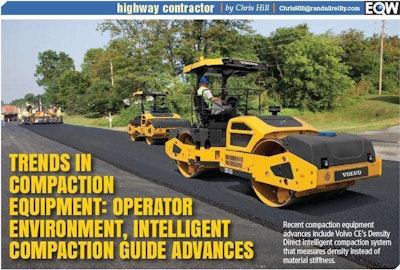
Operator environment
Design changes in compactors are evolving to dramatically improve visibility and to battle fatigue.
Tim Kowalski, application support manager for Wirtgen America’s Hamm compactors, says the company asks operators what they don’t like about the equipment to gauge what improvements and modifications are needed, rather than ask what they do like.
“If there is something they don’t like or would like to have, then we will look at making that change,” he says. “Two very simple things that we added to our newer HD+ models were cup holders and a place to put your lunch box. These two things alone changed the attitudes of many operators.”
Hamm also has been improving cab visibility to cut down on how much effort the operator must exert while running the machine, he says. Hamm compactors feature isolated and rubber mounted cabs to keep operators comfortable.

Hoffman says the machines also have been redesigned to dampen the vibrations in the operator’s platform and cut back on heat transfer to the operator by moving the engines to the rear of the machines. The seats and steering assemblies now slide sideways to allow operators to tweak their view. “This is less strenuous on the operator than a non-moveable seat because it doesn’t require the operator to lean for several hours while trying to get the best viewpoint,” he adds.
Volvo Construction Equipment has redesigned the operating controls in its machines to accommodate a wide range of operator size, according to Mark Eckert, compaction product manager.
To do this they worked with some averages, designing controls so they can be reached by the 5th percentile female size (smallest) to the 95th percentile male size (largest).“Proper positioning of operating controls lessens fatigue during long work shifts and reduces the risk of operating accidents,” Eckert says.
Operator safety is a top priority for Volvo CE as well, with improved visibility being a big part of recent designs. An operator is able to see objects (39 inches high at a distance of 39 inches) from the ends and sides of the machine.
Volvo has concentrated on reducing felt vibration, and noise levels to the operator’s ear and reducing operator fatigue.
To help with training, BOMAG is opening its new FAYAT Academy training center in Ridgeway, South Carolina, this fall. It will offer year-round opportunities in both classroom and hands-on environments. “This will offer customers the ability to receive a deeper level of training, so they can take full advantage of the machine’s capabilities and work more efficiently,” says Bert Erdman, product manager for heavy compaction.
Volvo CE offers similar training at its Road Institute, a program that’s a continuation of training offered by Blaw-Knox and Ingersoll Rand decades ago.
Intelligent compaction
The nearly ubiquitous IC has been the main focus of recent advances, and there is no indication that will change in the near term. Like those focused on the operator environment, IC developments are all about productivity.
“Customers are more focused on understanding how to maximize the use of the (IC) technology available than looking for more innovations,” says Bryan Downing, Caterpillar Paving global sales and support consultant. “The science behind compaction is making great advancements in a relatively short amount of time, so most of our customers are making more requests for training.”
Cat Paving’s Machine Drive Power (MDP) technology, now available with its Compaction Measurement Value, expands the capabilities of a single soil compactor. “While MDP works on all material types, its ability to provide indications of soil stiffness in cohesive soils has proven to be a niche measurement space that differentiates MDP,” Downing adds.
Although available for several years, IC has become popular in the past five years. “The Hamm Compaction Quality system has been a great success for our customers, providing them more consistent patterns, better density control, and cut down on the number of passes needed,” Kowalski says. “Unnecessary roller passes wastes time and money. I do not know of any contractor that doesn’t want to save time and money.”
Volvo CE says the most common customer request is for IC systems that incorporate pass counting and pass mapping capabilities. This led Volvo to develop its Density Direct system earlier this year.
“It uniquely provides the user with an indication of material density rather than a unit stiffness measure,” Eckert says in describing the difference between Volvo CE’s system and other IC systems. First introduced for the company’s double-drum vibratory compactors for flexible pavement, the states a variation is being developed for soil compaction as well.
BOMAG’s Economizer IC was launched more than two years ago for its light tandem rollers. It’s also now available in the company’s large tandem rollers and single drum rollers.
“The BOMAG Economizer provides our customers with a super simple and intuitive tool,” Erdman says, adding the system provides “on-the-fly” feedback of the compaction progress with a visual indicator on the control panel.
Atlas Copco’s fourth-generation Dyn@lyzer system has also proven popular. Hoffman adds contractors like being able to use the same system on both asphalt and soil. “This IC system also helps contractors from a quality assurance standpoint,” he says. “For instance, the contractor can use the data to prove to regulating agencies that compaction standards were met. Each stage of the compaction work is documented and presented to the operator in real-time.”
Future developments
Manufacturers are not done with IC development.
Volvo is looking into future designs that require less human control while not compromising safety or productivity.
Atlas Copco’s IC will be fully launched and ready to order in the fourth quarter of this year, and plans to launch a production-ready version of its CP1200 pneumatic roller at the 2016 World of Asphalt. It previously displayed a prototype at this year’s show.
Bomag’s enhancements on its single drum roller line will be introduced soon, as well as new tandem rollers.
Cat Paving’s recent Automatic Adjustable Compaction system for tandem drum vibratory asphalt rollers cuts back the amplitude of a roller as the mat becomes more compact. “This ensures uniform, high-quality compaction without complicated machine setup and allows the operator to focus on the compaction pattern being executed,” Downing says.
Kowalski says Hamm will remain focused on its IC system and is looking at ways to improve it, hinting that new advances may focus on changes to accommodate different asphalt mix designs, such as those including recycled materials. “We cannot look at rolling things the way used to,” he adds, referring to these new mix possibilities
Kowalski’s comments allude to perhaps the biggest development coming for compaction: data analysis. Specifically, says John Siekmeier with the Minnesota Department of Transportation’s (MnDOT) Office of Materials and Road Research, this would be in the form of enhanced visualization of IC data that ties this information from construction to pavement ride measurements, such as smoothness, years after construction.
What’s next for IC?
Data analysis will be the biggest next compaction development, says John Siekmeier with the Minnesota Department of Transportation’s (MnDOT) Office of Materials and Road Research.
As envisioned, this analysis would tie the IC data gained during construction to pavement ride measurements (such as smoothness) gathered years after construction. Siekmeier cites research done by Justice Harvieux, a current Stanford University structural engineering and geomechanics graduate student and recent student MnDOT engineer.
Harvieux headed a team of student researchers conducting a MnDOT study designed to create interactive visualization tools to fuse pavement performance and IC data. The researchers examined IC measurements from a 2005 project and compared it to performance data collected in 2014, seeking both a correlation between the two data sets and to develop visualization tools.
The research timing was good, since pavements start to show damage when they’re 10 years old, Harvieux says. “We wanted to connect how the IC data taken during construction could relate to how the pavement is performing now or in the future.” Harvieux believes this is where the industry is heading: connecting the data dots to analyze what works in road compaction.














